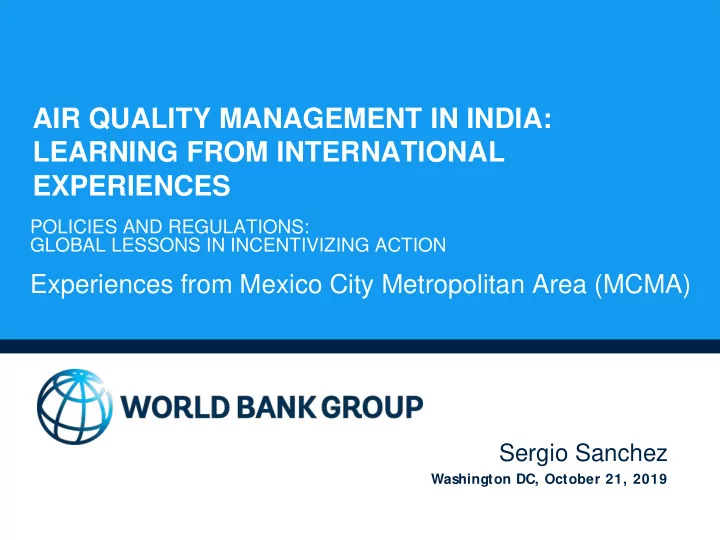

AIR QUALITY MANAGEMENT IN INDIA: LEARNING FROM INTERNATIONAL EXPERIENCES POLICIES AND REGULATIONS: GLOBAL LESSONS IN INCENTIVIZING ACTION Experiences from Mexico City Metropolitan Area (MCMA) Sergio Sanchez Washington DC, October 21, 2019
Key messages • Air pollution can be decoupled from economic growth with multiple environmental, social and economic benefits • Comprehensive air quality management plans with concrete short, medium and long term goals are indispensable to curve and abate air pollution levels. • Moreover, integrated clean air & climate actions lead to achieve both public health and greenhouse emission reduction objectives. • Key elements for success include empowered population, innovative governance, effective stakeholder engagement, institutional capacities, informed decision making and consistent resource allocation. 1 Footer Info
A fast industrialization and urbanization process, besides soil erosion, led to increasing air pollution levels in Mexico City the last third of the 20th Century. Presentation Title
In the mid eighties, air pollution issues quickly escalated to become a serious political concern. Mexico City was considered the most polluted city of the world, compromising quality of life and health for millions of people. Presentation Title
In the late eighties, a new air quality automatic monitoring network reveled all air pollutant concentrations were high and increasing compared to international standards. The Mexican President mandated local and federal authorities to issue and implement, for the first time ever, a Comprehensive Air Pollution Control Program.
1/17/2020 So far, three decades have passed of continued Comprehensive Air Quality Management in the MCMA • Multiple objectives • Multiple pollutants • Multiple government layers • Multiple jurisdictions • Multiple sectors • Multiple stakeholders
Ozone concentrations in the Mexico City Metropolitan Area (1988-2019) Presentation Title
1/17/2020 PM10 concentrations in the Mexico City Metropolitan Area (1989-2019) PM10 (1989-2019)
PM2.5 concentrations in the Mexico City Metropolitan Area (2004-2019)
”… the policies to control air pollution in Mexico City over the last twenty-five years have substantial benefits in terms of live saved and increased life expectancies. These health benefits can be monetized for cost-benefit analyses to inform public policy decisions. While the improvements in air quality and population health should be lauded, there is also evidence that further improvements in air quality would lead to additional public health benefits.” Douglas W. Dockery, Sc.D. John L. Loeb and Frances Lehman Loeb Research Professor of Environmental Epidemiology Harvard T.H. Chan School of Public Health
Benefits from reducing air pollution in the MCMA (1990 – 2014) Reductions in PM2.5 and ozone over the past twenty-five years have led to substantial improvements in health and reductions in mortality, saving ~ 20 thousand lives over the period. Air pollutant Attributable CI 95% exposure Deaths Avoided (thousands) Ozone 4.1 (2.7-5.6) PM 2.5 18.2 (14.0-23.5) PM2.5 & Ozone 22.5 (17.9-28.0)
Trends on tropospheric ozone pollution and major policies implemented (1990-2019)
1/17/2020 Major instruments to incentivize air quality improvement • National Air Quality Standards (Normas Oficiales Mexicanas) • Comprehensive air quality management programs • Policy instruments • Emission standards and fuel specifications • Economic instruments • Information instruments • [Traffic restrictions (No drive day or Hoy No Circula) + I&M program] • Others • Mexico City Metropolitan Area’s Environmental Trust Fund • Citizen air quality observatory
Traffic restrictions combined with the I&M program incentivize emission reduction and fleet renewal New Program to Prevent and Respond to Atmospheric Environmental Contingencies. Preventive Phase • 50% of the administrative cars of local, municipal, municipal and federal governments stop circulating. Phase 1 • 100% of administrative use cars from local and federal governments stop circulating. • 20% of the holograms "00", "0" stop circulating according to the termination of their plate, odds or pairs of hologram "1" and 100% of the holograms "2". Presentation Title
Continuous information from air quality monitoring and forecast incentivizes public engagement
1/17/2020 Major abatement strategies to incentivize air quality improvement • Clean Vehicles and Fuels • Low emission industrial development • Integrated land use and sustainable transport • Ecosystem restoration and environmental protection • Air quality management strengthening • Stakeholder engagement • Public participation, environmental education and research
Close articulation between federal and state governments is key to both implement regular measures and address air pollution episodes
MEXICO IS IN PROCESS OF IMPLEMENTING ITS NATIONAL AIR QUALITY STRATEGY TO FOSTER LOCAL COMPLIANCE LGEEPA EMISSIONS General Law of Ecological Equilibrium ENFORCEMENT AIR QUALITY INVENTORIES and Environment Protection M ONITORING CLEAN AIR ACTIONS SYSTEM PROGRAMS PUBLIC AWARENESS SECTORIAL AIRSHED I&M EMISSIONS DEFINITION LIMITS PROGRAMS AIR QUALITY STANDARDS NATIONAL AIR QUALITY STRATEGY Artist ANDY GOLDSWORTHY leaf-river-stone 1999
Mexico’s NDC incentivizes a comprehensive approach to deal with both local air pollution and climate simultaneously, through Black Carbon Non conditional goal Conditional goal -51% -70% Black Black Carbon Carbon -22% GHG -36% GHG
Conclusions • For over 25 years, Mexican institutions including both federal and subnational agencies have jointly implemented sound policies which have led to substantial air pollution reductions. • Mexico City is no longer the most polluted city in the world and not even in Mexico. It ranked in 2015 in the position 88th of the World Health Organization (2016), together with 42 cities that have PM2.5 concentrations of 22 ug/m3. • Implementation of public policies to improve air quality led pollution levels to maintain a downward trend for years, despite the steady growth of the City, the vehicle fleet and fuel consumption. • However, new air pollution level increasing trends has incentivized both federal and state governments to reinforce programs and abatement measures. Presentation Title
SERGIO SANCHEZ SENIOR ENVIRONMENTAL SPECIALIST ssanchez11@me.com 1/17/2020
Recommend
More recommend